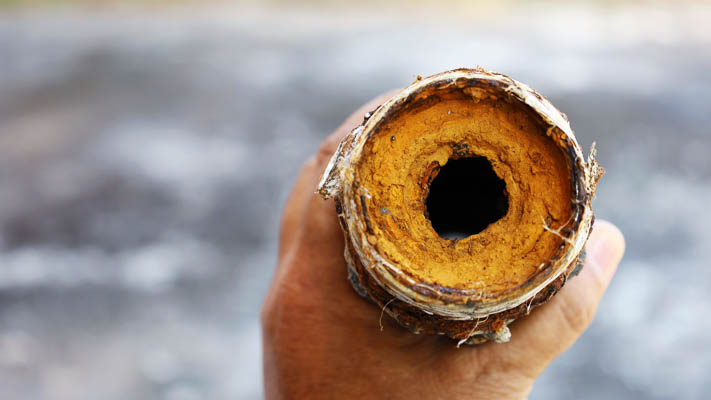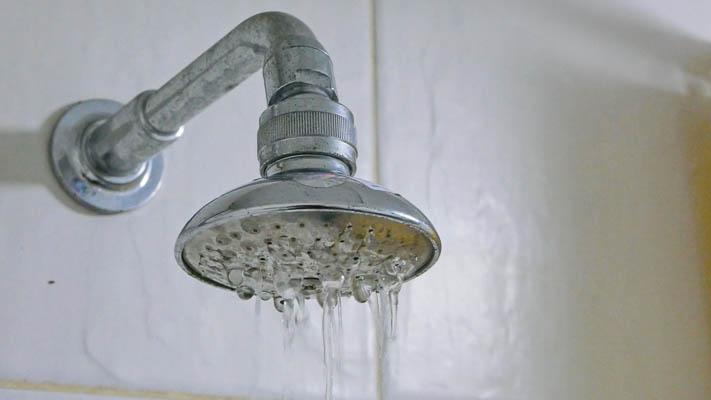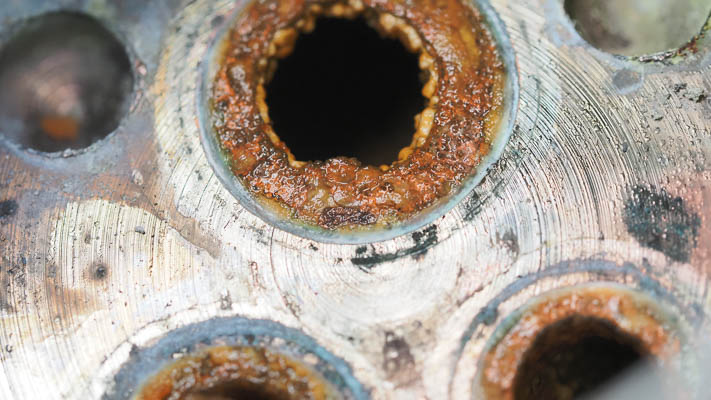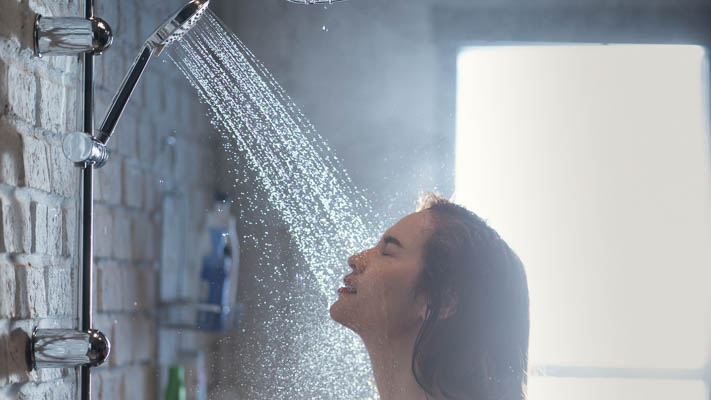Common Reasons You May Need To Increase Water Pressure
Before we can provide tips on how to increase your water pressure, we first need to identify why you have insufficient pressure in the first place. The reasons you may need to increase your water pressure fall into these general categories:
- Low municipal water pressure: the pressure delivered to your home at the water meter.
- Restrictions in your main supply line: the water pressure and water flow from the meter to your main shut-off and pressure regulating valve (if you have one).
- A systemic plumbing issue: problems with your overall plumbing system - like the presence of old galvanized pipes full of rust.

Galvanized pipe full of rust - A localized plumbing restriction: issues like clogged faucet or shower head screens causing a flow reduction.
- Problems with a well system: If you have a well system, there may be multiple reasons for low pressure depending on the type of system you have (gravity-fed vs. pressure tank). We provide consulting with a well system specialist to service and inspect your well system.
In this article we will focus on the ways to increase your pressure for the general categories above. We have a separate more detailed guide of all the common causes of low home water pressure.
How To Measure Your Home Water Pressure
To identify potential solutions for improving your water pressure, start by measuring it.
Normal residential water pressure typically ranges between 40 and 60 psi. Anything below 30 psi is considered too low and may prevent some appliances from functioning properly.
Measuring your water pressure is easy using inexpensive pressure gauges available at most hardware stores. These gauges can be attached to any of these common fixtures in your home:
- Outdoor hose spigots or hose bibs
- The supply connection to your washing machine
- The drain valve at the bottom of your water heater
Take readings at multiple locations throughout your home. Take one reading with all outlets closed and no water running (static pressure), and another with one outlet running (dynamic pressure).
These readings will help determine whether your water pressure issues stem from the supply line entering your home or from your internal plumbing.
Signs the cause of low pressure is in your internal plumbing
If your dynamic pressure is 10 psi or more lower than your static pressure, this strongly indicates restrictions within your internal pipes. Similarly, if you notice uneven flow rates from faucets in different parts of your house (such as low hot water flow while cold water flow is normal), you may need a whole-home repipe.

Jump to our section Do I Need a Repipe To Get High Water Pressure to learn which internal plumbing restrictions have simple fixes and which may require a full repipe.
Signs a low pressure issue is not in your internal plumbing
If the following are true:
- Uniform water flow across hot and cold lines
- Uniform water flow across multiple outlets throughout your home
- Dynamic pressure drop is less than 10-15 psi
- Static pressure is below 40 psi
Then the source of your low pressure is likely outside your internal plumbing. This can be either at the point where your water lines enter your home, in the main supply line between the meter and your home, or with the municipal supply itself.
Improving The Water Pressure Entering Your Home
If the pressure tests discussed earlier indicate that low pressure is not caused by your internal plumbing, here are the main ways to increase your water pressure:
1. Eliminate municipal water pressure as the cause of low pressure
If municipal water pressure is too low, there is limited action you can take. If the pressure drop was sudden, there may be a main break or leak. Check with your neighbors to see if they're experiencing low pressure as well.
If your neighbors don't have low pressure, your water meter or the shut-off valves near it could be restricting flow. Both the meter and upstream valves are the responsibility of your water supplier. Contact them to report pressure issues and have the meter and valves checked.
2. Check your main shut-off valve and pressure reducing valve (PRV)
Make sure your main shut-off valve is fully open. These valves are typically located near where your water pipes enter your home.
In areas with high municipal water pressure, homes often have a pressure reducing valve (PRV) to lower incoming pressure. PRVs typically last 10 to 15 years.
When a PRV begins to fail, you may notice pressure fluctuations or strange noises near the valve when water is running. If your PRV is over 10 years old and you see these signs, it probably needs replacement by a plumber.
PRVs can also be adjusted to increase or decrease pressure. Some models have built-in pressure gauges, making adjustments easier. More often, you'll need to measure pressure manually (as explained earlier) while adjusting the PRV.
3. Replace your main service line
If you've ruled out municipal pressure, PRV, and shut-off valve issues, your main service line from the meter to your home may need replacement.
Older service lines can accumulate scale from hard water or rust (in galvanized pipes), restricting flow. Also, if your home has been significantly expanded or remodeled since construction, your service line's diameter may be too small to meet increased water demand.

If you're unsure whether your service line needs replacing, contact us for a free consultation with a local repipe consultant. We can also provide referrals for services we don't offer, such as PRV replacement.
Get your free estimate today
With over 75,000 repipes completed, we've perfected our One-Stop Repipe™ for your home.
Do I Need to Repipe To Get High Water Pressure?
Problems in your internal home plumbing causing low flow or low pressure generally fall into two categories:
- Localized and temporary: These issues are usually easier to fix and rarely require significant pipe replacement.
- Systemic and long-term: These typically require pipe replacement, with a whole-home repipe often being the most cost-effective and least disruptive solution.
Solutions to Increase Water Pressure for Localized Plumbing Issues:
- Water softener systems: Filters in whole-home water softeners can become clogged over time. Regular inspection and maintenance are essential.
- Main line water filter: If your home has a whole-home water filter at the main line entry—similar to a water softener—it also requires regular inspection and servicing.
- Faucet and showerhead filter screens: Most faucets and showerheads have simple filter screens to catch debris. These should be cleaned and flushed regularly.
- Outlet valves and faucets clogged with scale: Minerals in hard water accumulate scale inside plumbing over time, especially in old faucets or shut-off valves, restricting water flow at those points. While these fixtures can sometimes be disassembled and cleaned, replacement is usually more cost-effective. If your fixtures are clogging with scale or rust, it likely indicates a systemic problem affecting your pipes as well.
Repiping: A Permanent Solution to Systemic Low Water Pressure
If your pipes and fittings have built up internal scale and rust, water flow throughout your home can become severely restricted. Old galvanized pipes clogged with rust are the most common cause of this issue. Additionally, in areas with hard water, any pipe type can clog over time, especially at fittings and connections.
There is no effective way to clean scale or rust inside pipes, so replacement is necessary. Moreover, a whole-home repipe is generally more cost-effective than multiple partial replacements done section-by-section.
Get a Quote On A Complete Home Repipe
Here at Repipe Specialists, we have fully replaced the plumbing in over 75,000 homes since 1991. We often receive positive feedback from our customers about how pleased they are with their fast-flowing, high-pressure water after the repipe. We also consistently hear great things about their overall home repipe experience. In fact, we frequently exceed their expectations in the following areas:
- Speed: Our repipe crews typically complete a repipe in a day, returning on another day for wall patching.
- Convenience: Through our One-Stop Repipe™ process, we handle everything from permits, to wall patching, to inspections.
- Cleanliness: Our crews are trained to protect your home while working (we cover all surfaces with protective sheeting), and to clean up fully at the end of each day.
- Peace of Mind: Repipe Specialists is a fully licensed plumber in every state we operate in, and we back all of our repipes with a lifetime warranty.
- Financing programs: To help take the sting out of unplanned repipe expenses, we offer several financing programs.
- Price: As a specialist that performs hundreds of repipes a week, we can deliver high-quality repipes at a lower cost vs generalist plumbers. We have an article that covers repipe cost factors in detail.
Schedule a free in-home consult, and one of our local repipe consultants will explain all your repipe options and provide you with a written, fixed-price quote.

